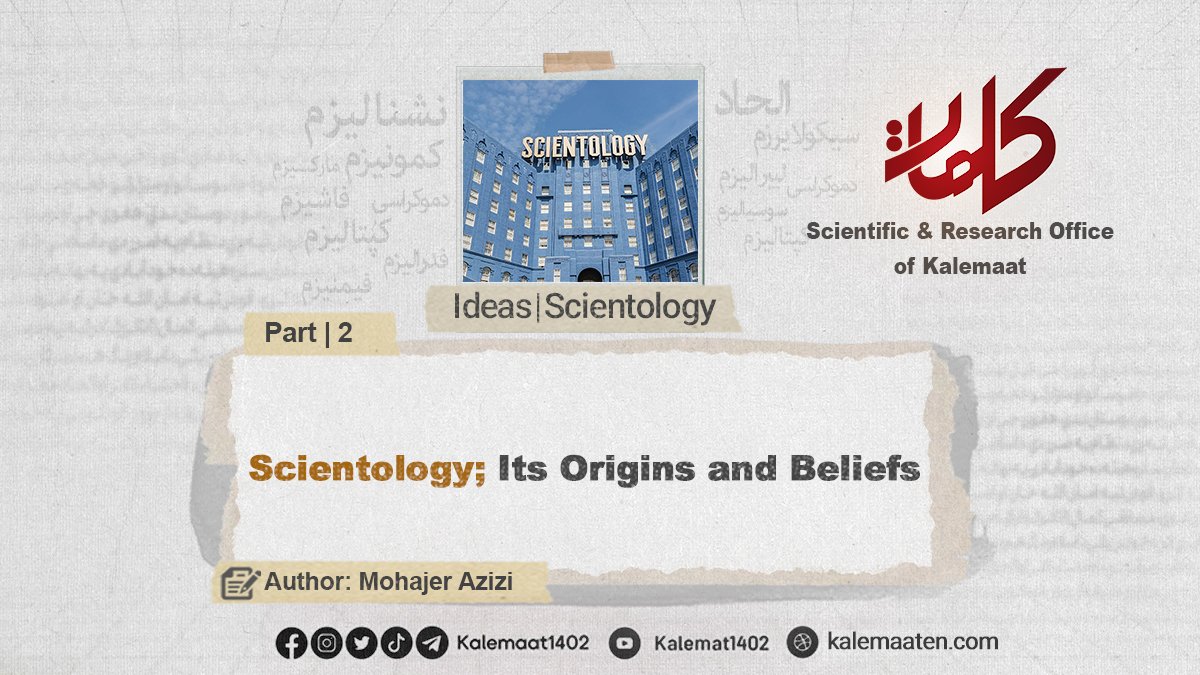Author: Mohajer Azizi
Scientology: its Origins and Beliefs (Part 2)
Etymology and History of Scientology
Etymology of the Term “Scientology”
The word Scientology is a combination of two Latin-derived components:
1. Scient (scientia), meaning knowledge or science.
2. -logy (logy), meaning study or the systematic study of a subject.
The term was first suggested by Alan Herbert, a friend of L. Ron Hubbard, in 1930. Later, Hubbard himself officially adopted it in 1950 as the name for his psychotherapy and belief system.
Linguistically, although Scientology resembles academic terms such as biology or geology, in the scholarly community it is recognized as a religion or a new religious movement rather than a legitimate scientific discipline.
History and Formation of Scientology
Before being recognized as a religion, Scientology went through several developmental stages. During World War II, Hubbard served in the U.S. Navy in Australia and was later wounded, leading to his hospitalization at the Oakland Naval Hospital in California. During this period, he began reflecting on human mental and physical problems. After the war, he pursued his personal exploration of the mind.
Hubbard first articulated his ideas in 1948 in the book The Original Thesis, where he systematized the mind and presented findings based on fundamental principles that, when applied, yield specific results.[1]
In 1950, he published another book, Dianetics: The Modern Science of Mental Health, claiming that most mental and physical problems stem from engrams, or mental recordings of traumatic experiences, including those from prenatal stages.
What moved Hubbard from Dianetics toward Scientology was his experience of the separation of self-awareness from the body. This led him to understand the thetan (spirit) and develop the belief that the spirit exists in other bodies prior to inhabiting the current one—a concept reminiscent of reincarnation in some Eastern religions.[2]
As Dianetics gained popularity, Hubbard realized that its concepts extended beyond psychotherapy into metaphysical and spiritual realms. Consequently, in 1952, he formally established Scientology as a spiritual religion, setting aside Dianetics to focus on the doctrines and practices of Scientology.
Scientology emerged amidst a period of religious experimentation in the United States. When conflicts arose among spiritual movements, the “International Scientology Movement” formed, aiming to analyze human mental disorders and offer practical solutions. Its rapid dissemination through publications and training programs allowed it to become the fastest-growing new religious movement in the U.S. Eventually, it established churches and administrative centers worldwide, with activities including Dianetics training, spiritual counseling, educational programs, and social campaigns like addiction recovery and literacy promotion.
Life of L. Ron Hubbard
Lafayette Ronald Hubbard was born in 1911 in Tilden, Nebraska, USA. He spent most of his childhood in Helena, Montana. In the 1920s, following his father’s naval posting to Guam, Hubbard traveled through Asia and the South Pacific.
In the early 1930s, before completing his education, he worked as a prolific writer of popular fiction and attended George Washington University in Washington, D.C. He briefly served in the U.S. Navy Reserve and, during World War II, commanded two ships, the USS YP-422 and USS PC-815, before being removed from command due to incompetence. The final months of his service were spent recovering in a hospital for a duodenal wound.
Later, he developed Dianetics—the “science of mental health”—and in 1952 founded Scientology, overseeing its growth into a global religious organization. During the 1960s and 1970s, he spent much of his time commanding a personal naval fleet composed of elite Scientology members. However, British, Greek, Spanish, Portuguese, and Venezuelan ports denied entry to his fleet, and courts in Australia and France challenged Scientology’s legitimacy, labeling Hubbard as a fraud. He returned to the U.S. in 1975 and lived in seclusion in California until his death in 1986.
The Church of Scientology venerates Hubbard as a prophet, while critics describe him as a charlatan, psychologically unstable, and deceitful. Many claims in his biography have been proven false, yet the Church maintains their validity.[3]
Religious Background and Influences
In his youth and prior to founding Scientology, Hubbard was not affiliated with any particular religion, identifying as a freethinker. His father, Harry Ross Hubbard, was a U.S. Navy officer with a relatively secular outlook, although the family had Christian roots.
Hubbard showed interest in philosophy, psychology, mythology, and other intellectual pursuits. Before creating Dianetics and Scientology, he explored various Eastern religions, including Buddhism[4] and Hinduism[5], as well as Western mysticism and Freemasonry. While he acquired knowledge of these systems, there is no evidence of formal adherence; instead, he integrated certain beliefs into Scientology—such as reincarnation and cycles of life—drawn from Hinduism and some Sufi teachings.
Continues…
Previous Part/ Next Part
References:
[1] Scientology-Dianetics, p. 36.
[2] Ibid., p. 23.
[3] Wikipedia.
[4] For a detailed study of Buddhist beliefs, see the Buddhism section on the Scientific and Research Words Administration website.
[5] For a detailed study of Hindu beliefs, see the Hinduism section on the Scientific and Research Words Administration website.



